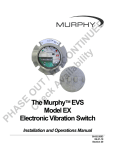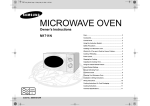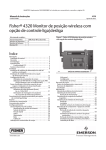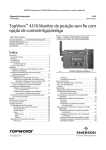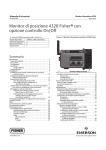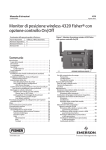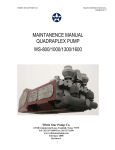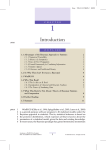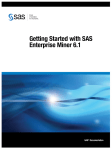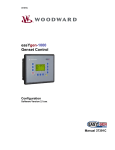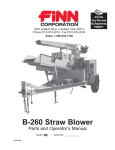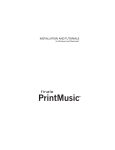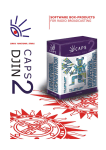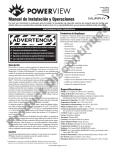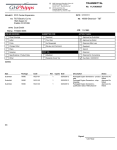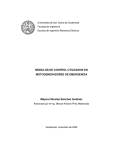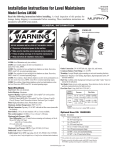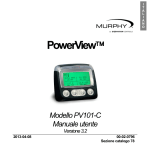Download Hurricane Booster-1000 OPERATING-PARTS
Transcript
ATTENTION! Please fill out and return! Your new Hurricane Compressor is covered by the warranty as explained in the warranty section in the end of this manual. Please fill in the following information and mail or fax this sheet back to the attention of the warranty department within 10 days of start-up of the unit to register your compressors. Thanks. Mailing Address: Warranty Department Atlas Copco Hurricane LLC 1015 Hurricane Road Franklin, Indiana 46131 Phone Number: 317-736-3800 Fax Number: 317-736-3801 Compressor Model Number_________________ Compressor Serial Number_______________ Date Placed In Service_____________________ Hour meter Reading____________________ End User Company Name_______________________________________________________ End User Company Street Address________________________________________________ End User City, State, Country, Zip_________________________________________________ End User Company Contact Person_______________________________________________ End User Telephone and Fax Numbers_____________________________________________ Distributor Name, City, State, Country______________________________________________ Comments or Suggestions: B7-41/1000 350 PSIG SUCTION 1000 PSIG DISCHARGE 2400 SCFM CAPACITY OPERATION / SERVICE / PARTS MANUAL BILL OF MATERIAL 10206 CO-AX AIR OPERATED VALVE AUTOLOAD / UNLOAD SYSTEM AUTO ENGINE IDLE WHEN UNLOADED BURGESS-MANNING INLET SCRUBBER FOUR POINT LIFTING +50°F APPROACH AFTERCOOLING #2 & #4 HOUSINGS WITH RINGFEDER COUPLING MURPHY PV100 ENGINE MONITOR CAT C7 T3 250HP@1899RPM DRIVE ENGINE OPERATION, MAINTENANCE AND PARTS MANUAL GENERAL SAFETY How to Work Safely With Your Compressor Before You Start the Compressor • Check all fluid levels and for possible leaks • Use adequate pressure rated hoses and couplings with proper cable restraints • Remove all tools and/or loose items from engine and pumper areas including fan area Use of Compressed Air • Air from this machine is NOT fit for human consumption- do NOT use air for breathing for food processing • Never operate in an enclosed area • Never use compressed air to clean your clothes; and never direct it at another person - IT CAN KILL • Wear eye protection Other Safety Precautions • Do not touch hot surfaces or moving parts - such as piping, exhaust, coolers • Do not adjust or restrict safety relief valves • Do not disconnect or alter shutdown sensors or switches • Do not clean machine with gasoline or volatile fluids • Do not refuel while machine is running; shutdown and allow to cool before refueling • Do not jump-start with cable connections direct on battery. Connect ground last, away from battery or frame Servicing • Disconnect battery if mechanical work is being performed • Remove radiator cap with caution, it may be pressurized when hot • Wipe up any spills resulting from servicing Lifting Procedure Designated personal shall do lifting or hoisting. The load capacity rating shall be clearly marked on hoist. Do not exceed load rating. Inspection and testing for cracks or defects in hoist system shall be performed on a regular basis. Before lifting, alert personnel in immediate areas. Do not stand under unit while it is being moved from one area to another on a hoist. Do not stand under unit to do service work. Read Manufacturer’s Service Manual Before Operating Compressor/Booster Failure to heed any of the above warnings or misuse of the compressor/booster even though not previously mentioned herein may result in severe injury or death, property damage, and mechanical failure, for which Atlas Copco Hurricane nor the Compressed Air and Gas Institute can be held responsible. GENERAL SAFETY (continued) If an operator cannot read or understand the manufactures safety and operating instructions, we strongly suggest the employer read (translate) and explain this information to the operator. Important Safety Instructions Look for these signs, which point out potential hazards to the safety of you and others. Read and understand thoroughly. Heed warnings and follow instructions. If you do not understand, inform your supervisor. Indicates the presence of a hazard, which WILL cause severe injury, death or property damage, if ignored. Indicates the presence of a hazard, which CAN cause severe injury, death or property damage, if ignored. Indicates the presence of a hazard, which WILL or CAN cause injury, death or property damage, if ignored Indicates important setup, operating or maintenance information. California Proposition 65 Warning – Diesel engine exhaust and some of its constituents are known to the state of California to cause cancer, birth defects and other reproductive harm. Warnings: This machine produces loud noises with the service valve vented. Extended exposure to loud noise can cause hearing loss. Always wear hearing protection when service valve is vented. Warning: High-pressure air can cause severe injury or death. Relieve pressure before recovering filter plugs, caps, fittings or covers. Danger: Air pressure can remain trapped in air supply line, which can result in serious injury or death. Always carefully vent air supply line at vent valve before performing any service. Warning: Do not remove the pressure cap from a HOT radiator. Allow radiator to cool before removing pressure cap. Danger: Disconnected air hoses whip. They can cause severe injury, death or property damage. Always use cable restraints. GENERAL SAFETY (continued) Warning: Never run unit with guard covers or screens removed. Keep hands, hair, clothing, tools, air gun tips, etc. away from moving parts. Hazardous Substance Precaution The following substances are used in the manufacture of this machine and may be hazardous to health if used incorrectly. Substance Antifreeze Compressor Lubricating Oil Engine Lubricating Oil Preservative Grease Rust Preventative Diesel Fuel Battery Electrolyte Precaution Avoid ingestion, skin contact and breathing fumes Avoid ingestion, skin contact and breathing fumes Avoid ingestion, skin contact and breathing fumes Avoid ingestion, skin contact and breathing fumes Avoid ingestion, skin contact and breathing fumes Avoid ingestion, skin contact and breathing fumes Avoid ingestion, skin contact and breathing fumes The following substances may be produced during the operation of this machine and may be hazardous to health. Substance Engine Exhaust Fumes Engine Exhaust Fumes Precaution Avoid breathing Avoid build-up of fumes in confined spaces COMPRESSOR CAPACITY @ 350 PSIG SUCTION 2400 SCFM @ 700 PSIG DISCHARGE @ 1925 RPM SEE CAPACITY SHEET IN OPERATION SECTION FOR MORE DETAIL MAXIMUM DISCHARGE PRESSURE 1000 PSIG OPERATING SPEED 1200 RPM - 1925 RPM MAXIMUM OVERALL COMPRESSION RATIO 2.78:1 FROM SUCTION ENGINE MODEL RATING FUEL ELECTRICAL SYSTEM CATERPILLAR C7 T3 250 BHP @ 1800 RPM IND-C INTERMITTENT CURVE DIESEL 24 VDC BOOSTER MEASUREMENTS OVERALL LENGTH OVERALL HEIGHT OVERALL WIDTH 8'-10" (106") 6'-8" (81") 5'-11" (71") WEIGHT DRY 6850 POUNDS WET 7870 POUNDS (WET INCLUDES OIL, OIL, COOLANT, FUEL, BATTERIES) FLUID CAPACITIES PUMPER LUBRICATING OIL ENGINE LUBRICATING OIL COOLANT SYSTEM FUEL TANK 2.25 GALLONS (INCLUDES FILTER) 7.50 GALLONS (INCLUDES FILTER) 22 GALLONS 80 GALLONS PUMPER STROKE 1ST STAGE DIAMETER 5.00" 2.50" x 4 CYLINDERS SAFETY RELIEF VALVE SETTINGS SUCTION 1ST STAGE 450 PSIG 1200 PSIG SET PRESSURES UNLOAD VALVE REGULATOR BACK PRESSURE REGULATOR DISCAHRE PRESSURE SWITCH 100 PSIG 400 PSIG 1000 PSIG MAXIMUM, OR DESIRED UNLOAD PRESSURE SHUT DOWN SET POINTS SUCTION HIGH GAS TEMPERATURE 1ST STAGE HIGH GAS TEMPERATURE LOW PUMPER OIL PRESSURE ENGINE OVERSPEED 160ºF 400ºF 20 PSIG 2100 RPM BATTERIES SIZE CCA @ 32ºF CCA @ 0ºF BATTERY VOLTAGE CIRCUIT CIRCUIT VOLTAGE QUANTITY 1231MF 1260 1100 12 VDC SERIES 24 VDC 2 INSTRUMENT PANEL SHUTDOWN SETPOINTS SUCTION HIGH GAS TEMPERATURE 160deg. F DISCHARGE HIGH GAS TEMPERATURE 400deg. F LOW PUMPER OIL PRESSURE 20 PSIG PRIOR TO START UP 1) SET THE BOOSTER ON LEVEL GROUND NOT TO EXCEED 5deg. IN ANY DIRECTION. 2) DO NOT SET BOOSTER WITHIN 8 FEET OF OTHER MACHINERY, BUILDINGS, OR ANY OBSTRUCTIONS THAT MAY HAMPER COOLING AIR FLOW TO AND FROM BOOSTER. 3) CONFIRM PRESSURE SWITCH AUTO UNLOAD PRESSURE. 4) CHECK ENGINE/PUMPER OIL AND COOLANT LEVELS. 5) DRAIN FLUID FROM INLET SCRUBBER TANK. 6) DRAIN FLUID FROM INTERSTAGE SEPERATOR TANKS. 7) CHECK THAT SUCTION HOSES ARE CLEAR OF DIRT AND DEBRIS. 8) DO NOT OPERATE WITHOUT SAFETY CABLES ON AIR HOSES. 9) DO NOT OPERATE WITH SAFETY DEVICES BY-PASSED. 10) DO NOT ATTEMPT TO START WITH AIR IN SYSTEM. 11) WARM UP PRIMARY SCREW COMPRESSORS. START UP PROCEDURE 1) CLOSE SUCTION AND DISCHARGE VALVES. 2) CLOSE INLET SCRUBBER TANK VALVE. 3) CONFIRM EMERGENCY STOP BUTTON IS IN EXTENDED POSITION. 4) TURN UNLOAD/AUTOLOAD SWITCH TO UNLOAD. 5) TURN OFF/RUN/BY-PASS SWITCH TO BY-PASS. 6) RESET ANY TRIPPED TATTLE-TALES. 7) PUSH START BUTTON AND HOLD IN UNTIL ENGINE FIRES. DO NOT ENGAGE STARTER FOR MORE THAN 15 SECONDS INTERVALS, ALLOWING TIME FOR STARTER TO COOL. 8) HOLD OFF/RUN/BY-PASS SWITCH TO BY-PASS POSITION UNTIL PUMPER OIL PRESSURE IS ABOVE 20 PSIG. WHEN PRESSURE OF PUMPER IS ABOVE 20 PSIG, RELEASE SWITCH TO RUN POSITION. IF PUMPER OIL PRESSURE DOES NOT IMMEDIATELY CLIMB, STOP BOOSTER AND INVESTIGATE PROBLEM. 9) SLOWLEY OPEN SUCTION VALVE. 10) DO NOT LOAD BOOSTER UNTIL COOLANT TEMPERATURE REACHES 1301F. 11) SLOWLEY OPEN DISCHARGE VALVE. AUTOMATIC BOOSTER LOADING 1) TURN UNLOAD/AUTOLOAD SWITCH TO AUTOLOAD POSITION. 2) INCREASE / DECREASE ENGINE SPEED TO MATCH DESIRED CAPACITY. 3) BOOSTER WILL BEGIN TO BUILD PRESSURE IF THERE IS SUFFICIENT RESTRICTION DOWN LINE. 4) BOOSTER WILL AUTOMATICALLY UNLOAD AND LOAD ACCORDING TO PRESSURE SWITCH SETTING. MANUAL UNLOAD 1) TURN UNLOAD/AUTOLOAD SWITCH TO UNLOAD POSITION. ROUTINE SHUTDOWN PROCEDURE 1) TURN UNLOAD/AUTOLOAD SWITCH TO UNLOAD POSITION. 2) ALLOW BOOSTER TO RUN FOR 5 MINUTES TO COOLDOWN. 3) CLOSE SUCTION AND DISCHARGE VALVES. 4) TURN OFF/RUN/BY-PASS SWITCH TO OFF POSITION. 5) OPEN INLET SCRUBBER TANK VALVE. EMERGENCY SHUTDOWN PROCEDURE 1) PRESS EMERGENCY STOP BUTTON ON SIDE OF INSTRUMENT PANEL. 2) CLOSE SUCTION AND DISCHARGE VALVES. 3) OPEN INLET SCRUBBER TANK VALVE. 4) TURN OFF/RUN/BY-PASS SWITCH TO OFF POSTION. 5) TURN UNLOAD/AUTOLOAD SWITCH TO UNLOAD POSITION. CAPACITY CHART B7-41/1000 2.50 DIAMETER PISTONS 350 PSIG MAXIMUM SUCTION 1000 PSIG MAXIMUM DISCHARGE 2.78:1 MAXIMUM OVERALL COMPRESSION RATIO FROM SUCTION CAPACITY SCFM AT VARIOUS PRESSURE AND RPM SUCTION PSIG DISCHARGE PSIG 1925 RPM 1800 RPM 1600 RPM 1400 RPM 1200 RPM 350 1000 N/R 2160 SCFM 1920 SCFM 1680 SCFM 1440 SCFM 350 700 2440 SCFM 2280 SCFM 2030 SCFM 1770 SCFM 1520 SCFM 325 930 2150 SCFM 2010 SCFM 1790 SCFM 1570 SCFM 1340 SCFM 300 860 2000 SCFM 1870 SCFM 1660 SCFM 1450 SCFM 1240 SCFM 275 790 1840 SCFM 1720 SCFM 1530 SCFM 1340 SCFM 1150 SCFM 250 750 1680 SCFM 1570 SCFM 1400 SCFM 1220 SCFM 1050 SCFM CAPACITY (S L/s) AT VARIOUS PRESSURE AND RPM SUCTION BAR DISCHARGE BAR 1925 RPM 1800 RPM 1600 RPM 1400 RPM 1200 RPM 24 69 N/R 1019 906 793 680 24 48 1152 1076 958 835 717 22 64 1015 949 845 741 632 21 59 944 883 783 684 585 19 54 868 812 722 632 543 17 52 793 741 661 576 496 PREVENTATIVE MAINTENANCE SCHEDULE IF OPERATING IN EXTREME ENVIRONMENTAL CONDITIONS (VERY HOT, COLD, DUSTY, OR WET), THESE TIME PERIODS SHOULD BE REDUCED. R = REPLACE C = CHECK (ADJUST OR REPLACE IF NECESSARY) L = LUBRICATE HOURLY DRAIN INLET SCRUBBER TANK (OR AS NEEDED). CAUTION - DRAIN INLET SCRUBBER TANK MORE OFTEN AS NEEDED WHEN OPERATING DURING HIGH HUMIDITY. DANGER - DO NOT ALLOW INLET SCRUBBER TANK FLUID LEVEL TO RISE ABOVE SIGHT GLASS. DANGER - FAILURE TO DRAIN INLET SCRUBBER TANK MAY RESULT IN COMPRESSOR VALVE DAMAGE OR HYDRAULIC LOCK. C DAILY WALK AROUND INSPECTION PUMPER OIL LEVEL ENGINE OIL LEVEL C COOLANT SYSTEM LEVEL AIR FILTER RESTRICTION INDICATOR GAUGES/LIGHTS FUEL TANK (FILL AT END OF DAY) C C C C MONTHLY FAN BELTS HOSES AND CLAMPS (AIR, OIL, COOLANT) COOLERS AND RADIATOR AUTOMATIC SHUTDOWN SYSTEM (TEST) FASTENERS C C C C C 3 MONTHS COOLERS AND RADIATOR (CLEAN EXTERIOR) C 250 HOURS PUMPER OIL AND FILTER CHANGE L/R MAINTAIN DRIVE ENGINE PER CATERPILLAR ENGINE MANUAL C C DRIVE ENGINE REFER TO CATERPILLAR ENGINE MANUALS FOR ALL CATERPILLAR ENGINE RELATED SERVICE, ADJUSTMENTS, AND SPECIFICATIONS. DRIVE ENGINE AND PUMPER OIL LEVEL MAINTAIN BETWEEN FULL AND ADD CRANKCASE LUBRICATION OIL LUBRICANT VISCOSITY CHART FOR OUTSIDE AMBIENT TEMPERATURES OIL VISCOSITY SAE 0W-20 SAE 0W-30 SAE 0W-40 SAE 5W-30 SAE 5W-40 SAE 10W-30 SAE 15W-40 - - AMBIENT 1F MINIMUM MAXIMUM -40 50 -40 86 -40 104 -22 86 -22 104 -4 104 5 122 SELECT OIL VISCOSITY BASED UPON MAXIMUM EXPECTED OPERATING TEMPERATURE. START UP AT LOWER THAN SPECIFIED AMBIENT TEMPERATURE REQUIRES CAUTION. START UP AT VERY LOW AMBIENT TEMPERATURES MAY REQUIRE AUXILIARY OIL HEATERS AND JACKET WATER HEATERS OR OTHER METHODS TO INCREASE CRANKCASE TEMPERATURES. TO DETERMINE IF THE OIL IN THE CRANKCASE WILL FLOW IN COLD WEATHER, REMOVE THE OIL DIPSTICK BEFORE STARTING. IF THE OIL WILL FLOW OFF THE DIPSTICK, THE OIL IS FLUID ENOUGH TO CIRCULATE PROPERLY. SELECT AN OIL WITH API CH-4 (PREFERRED) OR API CG-4 (PREFERRED) OR API CF-4 (ACCEPTABLE) CERTIFICATION. SYNTHETIC BASE STOCK OILS ARE ACCEPTABLE FOR USE. SYNTHETIC BASE STOCK OILS OUTPERFORM NON-SYNTHETIC OILS IN IMPROVED LOW TEMPERATURE VISCOSITY CHARACTERISTICS, ESPECIALLY IN ARCTIC CONDITIONS, AND IMPROVED OXIDATION STABILITY, ESPECIALLY AT HIGH OPERATING TEMPERATURES. RECOMMENDED CRANKCASE OILS - MOBIL DELVAC 1300 SUPER 15W-40 MOBIL DELVAC 1300 SUPER 10W-30 MOBIL DELVAC 1 SYNTHETIC 5W-40 RADIATOR THE ENGINE COOLING SYSTEM IS FILLED AT THE FACTORY WITH A 50/50 MIXTURE OF DISTILLED WATER AND ETHYLENE GLYCOL. THIS IS A PERMANENT TYPE ANTIFREEZE WHICH CONTAINS RUST INHIBITORS AND PROVIDES PROTECTION TO -35deg. F. IT IS RECOMMENDED THAT THE RADIATOR BE CLEANED BY DIRECTING COMPRESSED AIR OPPOSITE FAN FLOW DIRECTION WHICH CONTAINS A NON-FLAMMABLE SAFETY SOLVENT THROUGH THE CORE OF THE COOLER FINS. VENT SYSTEM WHEN FILLING, INCLUDING PUMPER BLOCK AND COMPRESSOR VALVE COOLING FITTINGS. COOLERS THE COMPRESSOR SUCTION AND DISCHARGE AIR COOLS BY MEANS OF FIN AND TUBE TYPE COOLERS, LOCATED AT THE PUMPER END OF THE COMPRESSOR. THE AIR FLOWING INTERNALLY THROUGH THE TUBE SECTION IS COOLED BY THE AIR STREAM PASSING THROUGH THE FIN SECTION FROM THE FAN. WHEN GREASE, OIL, AND DIRT ACCUMULATE ON THE EXTERIOR SURFACES OF THE COOLERS THEIR EFFICIENCY IS IMPAIRED. IT IS RECOMMENDED THAT THE COOLERS BE CLEANED BY DIRECTING COMPRESSED AIR OPPOSITE FAN FLOW DIRECTION WHICH CONTAINS A NON-FLAMMABLE SAFETY SOLVENT THROUGH THE CORE OF THE COOLER FINS. BATTERIES HEAVY-DUTY, DIESEL CRANKING TYPE BATTERIES WERE INSTALLED AT THE FACTORY. KEEP BATTERY POST TO CABLE CONNECTIONS CLEAN, TIGHT, AND LIGHTLY COATED WITH CORROSION PREVENTATIVE. THE ELECTROLYTE LEVEL IN EACH CELL SHOULD COVER THE TIPS OF THE PLATES. IF NECESSARY, TOPOFF WITH DISTILLED WATER. INLET SCRUBBER TANK DRAIN HOURLY OR AS NEEDED. CAUTION - DRAIN INLET SCRUBBER TANK MORE OFTEN AS NEEDED WHEN OPERATING DURING HIGH HUMIDITY. DANGER - DO NOT ALLOW INLET SCRUBBER TANK FLUID LEVEL TO RISE ABOVE SIGHT GLASS. DANGER - FAILURE TO DRAIN INLET SCRUBBER TANK MAY RESULT IN COMPRESSOR VALVE DAMAGE OR HYDRAULIC LOCK. AIR CLEANER THE DRIVE ENGINE IS EQUIPPED WITH AIR FILTER RESTRICTION INDICATOR. IF THE INDICATOR SHOWS RED THE ELEMENT SHOULD BE REPLACED. THE AIR CLEANER HOUSING AND PIPING SHOULD BE INSPECTED FOR LEAKAGE PATHS OR INLET OBSTRUCTIONS. COMPRESSOR VALVE INSPECTION 1) 2) 3) 4) 5) 6) REMOVE SUCTION PIPING FROM BOOSTER HEAD. PRESSURIZE DISCHARGE MANIFOLD WITH AIR OR NITROGEN FROM 80 PSIG TO 100 PSIG CHECK ALL AREAS FOR O-RING LEAKS AIR LEAKING INTO THE SUCTION PORT OF THE HEAD IS MOST LIKELY A DAMAGED INNER O-RING ON VALVE ADAPTER PLATE OR HEAD. IT COULD ALSO BE A WORN/BROKEN COMPRESSOR VALVE OR DAMAGED INTERNAL COMPRESSOR VALVE O-RING. USE A STRAIGHT BLADED SCREWDRIVER TO PUSH THE INTAKE PLATE OF THE COMPRESSOR VALVE DOWN. THIS MAY REQUIRE A SLIGHT BUMP FROM THE HEEL OF YOUR HAND. A BURPING SOUND AND A SHORT RUSH OF AIR IS NORMAL. A VERY SLIGHT LEAK INDICATED BY A QUIET HISSING SOUND IS OKAY. CONTINUE BUMPING THE INTAKE PLATE AROUND THE COMPRESSOR VALVE TO CLEAN OUT ANY OIL AND/OR DEBRIS. A CONTINUED RUSH AND LOUD HISSING OF AIR WHILE HOLDING THE INTAKE PLATE OPEN IS MOST LIKELY A WORN/BROKEN DISCHARGE SIDE COMPRESSOR VALVE. IT COULD ALSO BE A DAMAGED INTERNAL COMPRESSOR VALVE O-RING. SERVICE INTERVALS B-41 BOM 10206 1 2 3 4 5 6 7 8 9 10 11 12 13 14 15 16 17 18 19 20 21 22 23 24 25 26 27 (1) (2) (3) (4) Service Packs Part Numbers Drain inlet scrubber tank & interstage seperator tank (1) Take service readings (air, oil temps/pressures) Check for air- fuel- coolant- & oil leakage Check electrolyte level and terminals of battery Check fixation of hoses, cables and pipes Check oil and coolant level ( Pumper & Engine ) Check air filter restriction indicator Check all sensitive bolt connections Check shutdown devices Check coolers and clean externally Check condition of cooling fan assembly Clean air cleaner and dust bowl Drain water in fuel filter Inspect fuel tank for condensate and drain Replace engine oil & filter Lubricate pumper fan drive Replace pumper oil & filter Replace engine fuel filter Check glycol & PH level in coolant (3) Test shutdown system Check the tension and condition of the drive belts Check all sensitive bolt connections Change element air cleaner primary Change element air cleaner safety cartridge Change Pumper O-rings Check piston and replace if needed (4) Change valves Hourly NA x Drain more often as needed when operating during high humidity Use genuine ParOIL PARcool change interval = min. every 5 years Piston service pack can be ordered : Service Pack # 2236 2000 08 Daily NA x x x x x x x x x x x x x 250 500 or 1 year 1000 2000 HRS 2236 2000 04 2236 2000 05 2236 2000 06 2236 2000 07 x x x x x x x x x x x x x x x x x x x x x x x x x x x x x x x x x x x x x x x x x x x x x x x x x x x x x x x x x x x x x x x x x x x x x x x x x x x x x x x x x x x x x x x x x x x x x x x x x x Hurricane Compressors Booster Fogging Procedures If the booster is not going to be used for a period over 7 days, the following procedure should be used to minimize internal rusting of booster components Do not run the drive engine at any point during this procedure 1. Drain all water from the scrubber tank(s) and close the valve(s) 2. Prepare the sprayer with a 50/50 mix of engine oil and volatile corrosion inhibitor (VCI) oil (HPN 64117) 3. Remove connections at booster suction and discharge valves 4. Open the booster suction and discharge valves Do not allow the engine to start during step 5 5. Crank the drive engine at 15 second intervals, pausing one minute between cranking, while spraying the oil mixture into the suction valve 6. Repeat step 5 until oil mist is visible from discharge valve, a minimum of 6 ounces is recommended 7. Close booster suction valve/connection 8. Close booster discharge valve/connection 9. Plug pumper block breather hoses 10. Ensure that the scrubber tank valves are closed and the system is completely sealed INSTRUMENT PANEL FAULT CODES ENGINE FAULT THE ENGINE FAULT TATTLETALE WILL POP OUT AND SHUTDOWN THE BOOSTER FOR THE FOLLOWING REASONS: 1) LOW PUMPER OIL PRESSURE AIR TEMP FAULT THE AIR TEMP FAULT TATTLETALE WILL POP OUT AND SHUTDOWN THE BOOSTER FOR THE FOLLOWING REASONS: 1) HIGH SUCTION AIR TEMPERATURE 2) HIGH 1ST STAGE AIR TEMPERATURE 3) HIGH DISCHARGE AIR TEMPERATURE THE LIQUID LEVEL FAULT TATTLETALE WILL POP OUT AND SHUTDOWN THE BOOSTER FOR THE FOLLOWING REASONS: 1) HIGH LIQUID LEVEL IN SCRUBBER TANK MURPHY POWERVIEW 100 CATERPILLAR ENGINE FAULTS WILL DISPLAY ON THE MURPHY POWERVIEW 100. REFER TO THE CATERPILLAR MANUAL FOR MORE INFORMATION. PV-02124N Revised 09-03 Section 78 00-02-0528 Installation and Operations Manual Please read the following information before installing. A visual inspection of this product for damage during shipping is recommended before mounting. It is your responsibility to have a qualified person install this unit. GENERAL INFORMATION WARNING BEFORE BEGINNING INSTALLATION OF THIS MURPHY PRODUCT ✔ ✔ ✔ ✔ Disconnect all electrical power to the machine. Make sure the machine cannot operate during installation. Follow all safety warnings of the machine manufacturer. Read and follow all installation instructions. Description Display Parameters The PowerView is a powerful new display in a line of components manufactured by FWMurphy as part of its J1939 MurphyLink™† Family. The J1939 MurphyLink™ Family of products have been developed to meet the needs for instrumentation and control on electronically controlled engines communicating using the SAE J1939 Controller Area Network (CAN). The PowerView System is comprised of the PowerView and the Mlink™ PowerView Gages. The PowerView is a multifunction tool that enables equipment operators to view many different engine or transmission parameters and service codes. The system provides a window into modern electronic engines and transmissions. The PowerView includes a graphical backlit LCD screen. It has excellent contrast and viewing from all angles. Back lighting can be controlled via menu or external dimmer potentiometer. The display can show either a single parameter or a quadrant display showing 4 parameters simultaneously. Diagnostic capabilities include fault codes with text translation for the most common fault conditions. The PowerView has four buttons using self-calibrating charge transfer activation technology, which eliminates the concern for pushbutton wear and failure. In addition operators can navigate the display with ease. Enhanced alarm indication with ultra bright alarm and shutdown LEDs (amber & red). It has a wide operating temperature range of -40 to +85º C (-40 to185º F), display viewing -40 to +75º C (-40 to 167º F), and increased environmental sealing to +/- 5 PSI (± 34kPa). In addition it features Deutsch DT style connectors molded into the case and fits quickly and easily into existing 2-1/16 in. (52 mm) gage opening with little effort. The following are some of the engine and transmission parameters displayed by the PowerView in English or Metric units (when applicable, consult engine or transmission manufacturer for SAE J939 supported parameters): ❖ Engine RPM ❖ Engine Hours ❖ Machine Hours ❖ System Voltage ❖ % Engine Load at the current RPM ❖ Coolant Temperature ❖ Oil Pressure ❖ Fuel Economy ❖ Throttle Position ❖ Engine Manifold Air Temperature ❖ Current Fuel Consumption ❖ Transmission Gear Oil Pressure ❖ Transmission Gear Oil Temperature ❖ Transmission Gear Position ❖ Active Service Codes ❖ Stored Service Codes from the engine ❖ Set Units for display (English or Metric) ❖ Engine Configuration Parameters Other components in the system are microprocessor-based Mlink™ PowerView Gages for displaying critical engine data broadcast by an electronic engine or transmission’s Engine Control Unit (ECU): engine RPM, oil pressure, coolant temperature, system voltage, etc. and a combination audible alarm and relay unit for warning and shutdown annunciation. Up to 32 components may be linked to the PowerView using a simple daisy chain wire connection scheme using RS485. The PowerView and all connected components can be powered by 12 or 24-volt systems. Warranty A two-year warranty on materials and workmanship is given with this FWMurphy product. A copy of the warranty may be viewed or printed by going to www.fwmurphy.com/warranty.asp. † MurphyLinkTM is a registered trademark of FWMurphy. All other trademarks and service marks used in this document are the property of their respective owners. PV-02124N page 1 of 17 GENERAL INFORMATION continued Key Pad Functions Table of Contents 1. 2. 3. 4. 5. 6. 7. 8. General Information page # Warnings.................................................... 1 Description................................................. 1 Display Parameters.................................... 1 General Information (continued) Table of Contents....................................... 2 Key Pad Functions..................................... 2 Mechanical Installation Specifications............................................. 3 Typical Mounting Dimensions................... 3 Typical Quick-connect Diagram................ 3 Electrical Installation PIN Connectors Nomenclature.................. 4 Typical Wiring Diagram............................ 4 Operations First Time Start Up................................... 5 Main Menu Navegation............................. 5 Stored Fault Codes.................................... 6 Engine Configuration Data....................... 6 Faults and Warnings............................... .7 Active Fault Codes................................... 8 Shutdown Codes...................................... 8 Back Light Adjustment............................ 9 Contrast Adjustment.............................. 10 Select Units............................................... 10 Setup 1-Up Display................................... 11 Setup 4-Up Display.................................. 14 Utilities.....................................................15 J1939 Parameters....................................16 Glossary...................................................17 Amber Warning LED Display Menu Key Left Arrow Key Right Arrow Key Enter Key Bezel Red Shutdown/Derate LED 1 8 2 7 3 6 4 5 Keypad Functions The keypad on the PowerView is a capacitive touch sensing system. There are no mechanical switches to wear or stick, and the technology has been time proven in many applications. It operates in extreme temperatures, with gloves, through ice, snow, mud, grease, etc., and it allows complete sealing of the front of the PowerView. The ‘key is pressed’ feedback is provided by flashing the screen. The keys on the keypad perform the following functions: – Menu Key - The Menu Key is pressed to either enter or exit the menu screens. – Left Arrow - The Left Arrow Key is pressed to scroll through the screen either moving the parameter selection toward the left or downward. – Right Arrow - The Right Arrow Key is pressed to scroll through the screen either moving the parameter selection toward the right or upward. – Enter Key - The Enter Key (also known as Enter Button) is pressed to select the parameter that is highlighted on the screen. PV-02124N page 2 of 17 MECHANICAL INSTALLATION Specifications Typical Mounting Dimensions Display: 1.3 x 2.6 in. (33 x 66 mm), 64 x 128 pixels. Operating Voltage: 8 VDC minimum to 32 VDC max. Reversed Polarity: Withstands reversed battery terminal polarity indefinitely within operating temperatures. Operating Temperature: -40 to +85ºC (-40 to185ºF). Display Viewing Temperature: -40 to +75ºC (-40 to 167ºF). Storage Temperature: -40 to +85ºC (-40 to185ºF). Environmental Sealing: IP68, +/- 5 PSI (+/- 34.4 kPa). Power Supply Operating Current: (@ 14 VDC)= 52 mA minimum; 268 mA maximum (LCD heater on). CAN BUS: SAE J1939 Compliant. Case: Polycarbonate / Polyester. Clamp: Polyester (PBT). Connectors: 6-Pin Deutsch DTO6 Series. Maximum Panel Thickness: 3/8 in. (9.6 mm). Mounting Hole: 2.062 inch (52 mm) in diameter. Auxiliary Communications (Gages): One (1) RS485 port, MODBUS RTU master, 38.4K baud, N, 8, 1 or 2, half duplex. Potentiometer Input: 1K ohm, 1/4 W Shipping Weights (all models): 1 lb. (450 g.) Shipping Dimensions (all models): 6 x 6 x 6 in. (152 x 152 x 152 mm). FRONT BACK 4.25 in. (108 mm) 4.25 in. (108 mm) 3.489 in. (89 mm) SIDE HOLE CUTOUT 2.062 in. (52 mm) diameter 1.94 in. (50 mm) 1.972 in. (50 mm) 2.070 in. (53 mm) .953 in. (24 mm) 0.78 in. (20 mm) R 0.063 in. (1.6 mm) 0.125 in. (3 mm) 2.41 in. (61 mm) OR 3.18 in. (81 mm) Use a 2.062 in. (52 mm) diameter round hole. Typical Quick-Connect Diagram Last PVA Gage or PVAA Audible Alarm To Engine ECU A To optional external device To PVAA Audible Alarm B Terminating Resistor PVJR To Battery Power PVW-CH POWERVIEW PV100 A Relay N.O. B Relay N.C. OR Ext. Sonalert PVW-PH Relay Comm. Optional PVW-A wire harness Customer provided wire harness or CAN extension harnesses or power extension harnesses. (includes terminating resistor) A B PVA Gage Next PVA Gage Wire harness PVW-J External Dimmer Wire 24 inch. A External Dimmer B A B B+ GRND CAN–SHLD CAN–LO CAN–HI Wire harness PVW-P Wire harness PVW-J PV-02124N page 3 of 17 Wire harness PVW-J ELECTRICAL INSTALLATION PowerView Unit Back View Deutsch DT06-6S Style Connections Plug A Plug B PIN 3 CAN LO – PIN 4 CAN SHLD – PIN 2 CAN HI – PIN 5 Dimmer Potentiometer PIN 1 V+ PIN 3 RS485+ A PIN 4 RS485 – B PIN 6 GRND PIN 1 V+ PIN 6 GRND Recommended Connectors: Body: Deustch DT06-6S Wedge Lock: W6S Terminals: 0462-201-16141 Sealing Plug: 114017 Typical Wiring Diagram IMPORTANT: To eliminate external interference: RS485(+) and RS485(-) should be twisted pair cable or twist wires together, one twist per inch minimum. CAN–L, CAN–H and CAN Shield should be approved J1939 CAN bus cable (CAN wire for example: RADOX plug and play cable, from Champlain cable). (RS485 wire for example: BELDEN 9841 or 3105A). PowerView Deutsch DT06-6S Style Unit Back View White NOTE 5 NOTE 4 RS485 (+) Data Pin 3 Green-CAN_L Yellow-CAN_H 120 Ω See NOTE 6 Pin 3 120 Ω See Note or Pin 2 NOTE 1 Pin 1 Pin 5 Pin 1 Pin 6 Red-V+ Ignition Switch RS485 (-) Data Pin 4 Pin 4 Pin 6 ENGINE CONTROL MODULE (SAE J1939 Compliant) Orange NOTE 2 Gray-CAN_SHLD PVA Gage Black GRND Red V+ Black-Ground Brown-Back Light Battery Illumination Control*(optional) NOTE 3 Note 1: Place Resistor between CAN–H and CAN–L Line near PowerView (included in PVW-P or factory purchased panels). Note 4: Only use 120 ohm Note 2: Use SAE J1939 compliant to PowerView end only. wiring or equipment. Note 3: Electronic dimmer switch recommended with 4A, capacity or heavy duty rheostat switch, 1000 ohm, 0.25 watt. PV-02124N page 4 of 17 characteristic impedance cable, ex Belden 9841. Note 5: RS485 shield connected Note 6: Place Resistor at End of Line on last PVA gage. (Included for factory purchased panels.) POWERVIEW OPERATION PowerView Menus 2. The first seven items of the “Main Menu” will be displayed. GO TO 1-UP DISPLAY STORED CODES ENGINE CONF SETUP 1-UP DISPLAY SETUP 4-UP DISPLAY SELECT UNITS ADJUST BACKLIGHT First Time Start Up 1. When power is first applied to the PowerView, the "Logo Screen" will be displayed. 3. Depressing the "Arrow Buttons" will scroll through the menu selections. GO TO 1-UP DISPLAY STORED CODES ENGINE CONF SETUP 1-UP DISPLAY SETUP 4-UP DISPLAY SELECT UNITS ADJUST BACKLIGHT 2. The "Wait to Start" message will be displayed for engines with a pre-startup sequence. Once the "Wait to Start" message is no longer displayed the operator may start the engine. Note: Displays only when SAE J1939 message is supported by engine manufacturer. WAIT TO START 4. Pressing the right arrow button will scroll down to reveal the last items of “Main Menu” screen highlighting the next item down. PREHEAT ADJUST ADJUST CONTRAST CONTRAST UTILITIES 3. Once the engine has started the display will show the single engine parameter display. 0 1500 3000 1800 RPM ENG RPM COOL TEMP 5. Use the arrow buttons to scroll to the desired menu item or press the "Menu Button" to exit the Main menu and return to the engine parameter display. GO TO 1-UP DISPLAY Main Menu Navigation 1. Starting at the single or four engine parameter display, depress the "Menu Button". 98% 0 1500 3000 1800 RPM ENG RPM COOL TEMP LOAD@RPM 14.2 BAT VOLT STORED CODES ENGINE CONF SETUP 1-UP DISPLAY SETUP 4-UP DISPLAY SELECT UNITS ADJUST BACKLIGHT 1000 RPM ENG RPM 57 PSI OIL PRES PV-02124N page 5 of 17 98% LOAD@RPM 14.2 BAT VOLT 1000 RPM ENG RPM 57 PSI OIL PRES POWERVIEW OPERATION continued Stored Fault Codes 5. Press the "Menu Button" to return to the main menu. 1. Starting at the single or four engine parameter display depress the "Menu Button". 1500 3000 ENG RPM ENG RPM ▼ 1800 RPM SPN110 FMI10 HIGH COOLANT TEMP 1000 RPM 14.2 COOL TEMP BAT VOLT MORE ▼ 0 98% LOAD@RPM 1 of x HIDE 57 PSI OIL PRES 2. The main menu will pop up on the display. Use the "Arrow Buttons" to scroll through the menu until the "Stored Fault Codes" is highlighted. 6. Press the "Menu Button" to exit the Main menu and return to the engine parameter display. GO TO 1-UP DISPLAY 98% STORED CODES ENGINE CONFG SETUP 1-UP DISPLAY SETUP 4-UP DISPLAY SELECT UNITS ADJUST BACKLIGHT GO TO 1-UP DISPLAY STORED CODES STORED CODES ENGINE CONFG SETUP 1-UP DISPLAY SETUP 4-UP DISPLAY SELECT UNITS ADJUST BACKLIGHT LOAD@RPM 14.2 BAT VOLT 1000 RPM ENG RPM 57 PSI OIL PRES Engine Configuration Data 1. Starting at the single or four engine parameter display press the "Menu Button". 3. Once the "Stored Fault Codes" menu item has been highlighted press the "Enter Button" to view the "Stored Fault Codes". GO TO 1-UP DISPLAY STORED CODES STORED CODES ENGINE CONFG SETUP 1-UP DISPLAY SETUP 4-UP DISPLAY SELECT UNITS ADJUST BACKLIGHT 98% 0 1500 3000 1800 RPM ENG RPM COOL TEMP LOAD@RPM 14.2 BAT VOLT 1000 RPM ENG RPM 57 PSI OIL PRES 2. The main menu will pop up on the display. Use the "Arrow Buttons" to scroll through the menu until the "Engine Configuration" is highlighted. GO TO 1-UP DISPLAY STORED CODES ENGINE ENGINE CONFG CONFG SETUP 1-UP DISPLAY SETUP 4-UP DISPLAY SELECT UNITS ADJUST BACKLIGHT 4. If the word "MORE" appears above the "Arrow Buttons" there are more stored fault codes that may be viewed. Use the "Arrow Buttons" to scroll to the next Stored Diagnostic Code. 1 of x 3. Once the "Engine Configuration" menu item has been highlighted press the "Enter Button" to view the engine configuration data. ▼ MORE ▼ SPN110 FMI10 HIGH COOLANT TEMP GO TO 1-UP DISPLAY STORED CODES ENGINE ENGINE CONFG CONFG SETUP 1-UP DISPLAY SETUP 4-UP DISPLAY SELECT UNITS ADJUST BACKLIGHT HIDE PV-02124N page 6 of 17 POWERVIEW OPERATION continued 4. Use the "Arrow Buttons" to scroll through the engine configuration data. ENGINE SPEED PT 1 or normal operation an auxiliary gage should fail the single or four parameter screen will be replaced with the "MLink Gage Fault" message. 1000 RPM ENGINE OIL PRESSURE GAGE NOT RESPONDING ▼ ▼ MORE 1 of x HIDE 5. Press the "Menu Button" to return to the main menu. 3. To acknowledge and "Hide" the fault and return to the single or four parameter display press the "Enter Button". ENGINE SPEED PT 1 1000 RPM 1 of x ENGINE OIL PRESSURE GAGE NOT RESPONDING ▼ ▼ MORE HIDE 6. Press the "Menu Button" to exit the Main menu and return to the engine parameter display. GO TO 1-UP DISPLAY STORED CODES ENGINE CONFG CONFG SETUP 1-UP DISPLAY SETUP 4-UP DISPLAY SELECT UNITS ADJUST BACKLIGHT 98% LOAD@RPM 14.2 BAT VOLT 1000 RPM ENG RPM 4. The display will return to the single or four parameter screen. ! 57 PSI OIL PRES 0 1500 3000 1800 RPM ENG RPM COOL TEMP ! Faults and Warnings Auxiliary Gage Fault 1. During normal operation the single or four parameter screen will be displayed. 98% 0 1500 3000 1800 RPM ENG RPM COOL TEMP LOAD@RPM 14.2 BAT VOLT 98% 1000 RPM LOAD@RPM ENG RPM ! 14.2 BAT VOLT ! Indicates Auxiliary Gage Fault .! Indicates Fault Warning ! Indicates Derate or Shutdown Condition Fault 57 PSI OIL PRES ! 5. Pressing the "Enter Button" will redisplay the hidden fault. Pressing the "Enter Button" once again will hide the fault and return the screen to the single or four parameter display. NOTE: The fault can only be cleared by correcting the cause of the fault condition. 1000 RPM ENG RPM 57 PSI OIL PRES 2. The PVA Series of auxiliary gages can be attached to the PowerView. These auxiliary gages communicate with the Modbus master PowerView via a daisy-chained RS-485 port. If at any time during system initialization PV-02124N page 7 of 17 1 of x ENGINE OIL PRESSURE GAGE NOT RESPONDING HIDE POWERVIEW OPERATION continued Active Fault Codes 1. During normal operation the single or four parameter screen will be displayed. 98% 0 1500 LOAD@RPM 3000 1800 RPM ENG RPM 14.2 COOL TEMP BAT VOLT ! 1000 RPM 0 ENG RPM 1500 98% 3000 1000 RPM LOAD@RPM ENG RPM 1800 RPM ENG RPM 57 PSI COOL TEMP ! 14.2 ! 57 PSI OIL PRES BAT VOLT ! OIL PRES 2. When the PowerView receives a fault code from an engine control unit the single or four parameter screen will be replaced with the "Active Fault Codes" message. 1 of x 5. The display will return to the single or four parameter display, but the display will contain the "Active Fault"warning icon. Pressing the "Enter Button" will redisplay the hidden fault. 6. Pressing the "Enter Button" once again will hide the fault and return the screen to the single or four parameter display. WARNING 1 of x WARNING SPN110 FMI0 HIGH COOLANT TEMP SPN110 FMI0 ▼ MORE ▼ HIGH COOLANT TEMP MORE HIDE HIDE 3. If the word "MORE" appears above the "Arrow Buttons" there are more active fault codes that may be viewed. Use the "Arrow Buttons" to scroll to the next "Active Fault Code" 7. The Single or Four parameter screen will display the fault icon until the fault condition is corrected. NOTE: Ignoring active fault codes could result in severe engine damage. GO TO 1-UP DISPLAY 98% STORED CODES ENGINE CONFG SETUP 1-UP DISPLAY SETUP 4-UP DISPLAY SELECT UNITS ADJUST BACKLIGHT 1 of x SPN110 FMI0 1000 RPM LOAD@RPM ENG RPM ! 14.2 BAT VOLT 57 PSI OIL PRES ! ▼ MORE ▼ HIGH COOLANT TEMP HIDE Shutdown Codes 1. During normal operation the single or four parameter screen will be displayed. 98% 4. To acknowledge and "Hide" the fault and return to the single or four parameter display press the "Enter Button". 0 1500 3000 1800 RPM ENG RPM 1000 RPM LOAD@RPM ENG RPM 57 PSI 14.2 COOL TEMP OIL PRES BAT VOLT 1 of x SPN110 FMI0 HIGH COOLANT TEMP ▼ MORE HIDE 2. When the PowerView receives a severe fault code from an engine control unit the single or four parameter screen will be replaced with the "Shutdown!" message. 1 of x SHUTDOWN SPN110 FMI0 HIGH COOLANT TEMP MORE PV-02124N page 8 of 17 HIDE POWERVIEW OPERATION continued 3. To acknowledge and "Hide" the fault and return to the single or four parameter display press the "Enter Button". 2. The main menu will pop up on the display. Use the "Arrow Buttons" to scroll through the menu until the "Adjust Backlight" is highlighted. SHUTDOWN 1 of x GO TO 1-UP DISPLAY STORED CODES ENGINE CONFG SETUP 1-UP DISPLAY SETUP 4-UP DISPLAY SELECT UNITS ADJUST BACKLIGHT ADJUST BACKLIGHT SPN110 FM10 HIGH COOLANT TEMP MORE HIDE 4. The display will return to the single or four parameter display, but the display will contain the "Shut Down" icon. Pressing the "Enter Button" will redisplay the hidden fault. ! 0 1500 98% 1800 RPM GO TO 1-UP DISPLAY STORED CODES ENGINE CONFG SETUP 1-UP DISPLAY SETUP 4-UP DISPLAY SELECT UNITS ADJUST BACKLIGHT 1000 RPM LOAD & RPM 3000 3. Once the "Adjust Backlight" menu item has been highlighted press the "Enter Button" to activate the "Adjust Backlight" function. ENG RPM ! 57 PSI 14.2 ENG RPM COOL TEMP! OIL PRES BAT VOLT 5. Pressing the "Enter Button" once again will hide the fault and return the screen to the single or four parameter display. 1 of x 4. Use the "Arrow Buttons" to select the desired backlight intensity. SHUTDOWN SPN110 FM10 HIGH COOLANT TEMP MORE ADJUST BACKLIGHT HIDE 6. The Single or Four parameter screen will display the fault icon until the fault condition is corrected. NOTE: Ignoring active fault codes could result in severe engine damage. ! 0 1500 3000 98% ADJUST BACKLIGHT 1000 RPM LOAD & RPM ENG RPM ! 1800 RPM ENG RPM 5. Press the "Menu Button" to return to the main menu. 14.2 COOL TEMP ! BAT VOLT 57 PSI OIL PRES ! Back Light Adjustment 1. Starting at the single or four engine parameter display press the "Menu Button". 6. Press the "Menu Button" to exit the Main menu and return to the engine parameter display. GO TO 1-UP DISPLAY 98% 0 1500 3000 1800 RPM ENG RPM COOL TEMP LOAD@RPM 14.2 BAT VOLT 1000 RPM ENG RPM 57 PSI STORED CODES ENGINE CONFG SETUP 1-UP DISPLAY SETUP 4-UP DISPLAY SELECT UNITS ADJUST BACKLIGHT OIL PRES PV-02124N page 9 of 17 98% LOAD@RPM 14.2 BAT VOLT 1000 RPM ENG RPM 57 PSI OIL PRES POWERVIEW OPERATION continued Contrast Adjustment 1. Starting at the single or four engine parameter display depress the "Menu Button". 98% 0 1500 3000 1800 RPM ENG RPM COOL TEMP LOAD@RPM 14.2 BAT VOLT 6. Press the "Menu Button" to exit the Main menu and return to the engine parameter display. GO TO 1-UP DISPLAY 98% STORED CODES ENGINE CONFG SETUP 1-UP DISPLAY SETUP 4-UP DISPLAY SELECT UNITS ADJUST BACKLIGHT 1000 RPM ENG RPM 57 PSI LOAD@RPM 14.2 BAT VOLT 1000 RPM ENG RPM 57 PSI OIL PRES OIL PRES 2. The main menu will pop up on the display. Use the "Arrow Buttons" to scroll through the menu until "Adjust Contrast" is highlighted. Select Units 1. Starting at the single or four engine parameter display depress the "Menu Button". GO TO 1-UP DISPLAY STORED CODES ENGINE CONFG SETUP 1-UP DISPLAY SETUP 4-UP DISPLAY SELECT UNITS ADJUST BACKLIGHT 98% 0 1500 1800 RPM ENG RPM 3. Once the "Adjust Contrast" menu item has been highlighted press the "Enter Button" to activate the "Adjust Contrast" function. 4. Use the "Arrow Buttons" to select the desired contrast intensity. COOL TEMP LOAD@RPM 14.2 BAT VOLT 1000 RPM ENG RPM 57 PSI OIL PRES 2. The main menu will pop up on the display. Use the arrow buttons to scroll through the menu until the "Select Units" is highlighted. GO TO 1-UP DISPLAY STORED CODES ENGINE CONFG SETUP 1-UP DISPLAY SETUP 4-UP DISPLAY SELECT SELECTUNITSD UNITS ADJUST BACKLIGHT STORED CODES ENGINE CONFG SETUP 1-UP DISPLAY SETUP 4-UP DISPLAY SELECT UNITS ADJUST BACKLIGHT ADJUST CONTRAST 3. Once the "Select Units" menu item has been highlighted press the "Enter Button" to access the "Select Units" function. GO TO 1-UP DISPLAY STORED CODES ENGINE CONFG SETUP 1-UP DISPLAY SETUP 4-UP DISPLAY SELECT SELECTUNITSD UNITS ADJUST BACKLIGHT ADJUST CONTRAST 5. Press the "Menu Button" to return to the main menu. 3000 4. Use the arrows to highlight the desired units. "English" for Imperial units i.e. PSI, ºF or Metric kPa, Metric Bar for IS units i.e. kPa, Bar, ºC. ENGLISH METRIC KPA METRIC BAR ADJUST CONTRAST PV-02124N page 10 of 17 POWERVIEW OPERATION continued 5. Press the "Enter Button" to select the highlighted units. 3. Once the "Setup 1-up Display" menu item has been highlighted press the "Enter Button" to access the "Setup 1-up Display" function. ENGLISH METRIC KPA METRIC BAR GO TO 1-UP DISPLAY STORED CODES ENGINE CONFG SETUP SETUP1-UP 1-UPDISPLAY DISPLAY SETUP 4-UP DISPLAY SELECT UNITSD ADJUST BACKLIGHT 6. Press the "Menu Button" to return to the "Main Menu". 4. Three options are available for modification of the 1-Up display. a). Use Defaults – This option contains a set of engine parameters: Engine Hours, Engine RPM, System Voltage, Battery Voltage, % Engine Load at Current RPM, Coolant Temperature, Oil Pressure. b). Custom Setup – This option allows for the modification of what parameter, the number of parameters, and the order in which the parameters are being displayed. c). Automatic Scan – Selecting the scan function will cause the 1-Up Display to scroll through the selected set of parameters one at a time, momentarily pausing at each. ENGLISH METRIC KPA METRIC BAR 7. Press the "Menu Button" to exit the Main menu and return to the engine parameter display. GO TO 1-UP DISPLAY 98% STORED CODES ENGINE CONFG SETUP 1-UP DISPLAY SETUP 4-UP DISPLAY SELECT UNITS ADJUST BACKLIGHT LOAD@RPM 14.2 BAT VOLT 5. Use Defaults - To select "Use Defaults" use the arrow buttons to scroll to and highlight "Use Defaults" in the menu display. USE DEFAULTS DEFAULTS USE CUSTOM SETUP AUTOMATIC SCAN OFF 1000 RPM ENG RPM 57 PSI OIL PRES 6. Press the "Enter Button" to activate the "Use Defaults" function. USE USEDEFAULTS DEFAULTS CUSTOM SETUP AUTOMATIC SCAN OFF Setup 1-Up Display 1. Starting at the single engine parameter display press the "Menu Button". 98% 0 1500 3000 1800 RPM ENG RPM COOL TEMP LOAD@RPM 14.2 BAT VOLT 1000 RPM ENG RPM 57 PSI OIL PRES 2. The main menu will pop up on the display. Use the "Arrow Buttons" to scroll through the menu until the "Setup 1-up Display" is highlighted. 7. A message indicating the “Single Engine” parameter display parameters are reset to the factory defaults will be displayed, then the display will return to the “Custom Setup” menu. RESTORED TO DEFAULTS GO TO 1-UP DISPLAY STORED CODES ENGINE CONFG SETUP1-UP 1-UPDISPLAY DISPLAY SETUP SETUP 4-UP DISPLAY SELECT UNITSD ADJUST BACKLIGHT PV-02124N page 11 of 17 POWERVIEW OPERATION continued 8. Custom Setup - To perform a custom setup of the 1-Up Display use the arrow buttons to scroll to and highlight "Custom Setup" on the display. 13. Press the "Enter button" to select the highlighted parameter for inclusion in the Single Engine Parameter Display. USE DEFAULTS CUSTOM CUSTOMSETUP SETUP AUTOMATIC SCAN OFF ENGINE SPEED PERCENT LOAD AT CURRENT RPM 2 ENGINE OIL PRESSURE 1 ENGINE COOLANT TEMP 3 9. Pressing the "Enter Button" will display a list of engine parameters. USE DEFAULTS CUSTOM CUSTOMSETUP SETUP AUTOMATIC SCAN OFF 14. Continue to scroll and select additional parameters for the custom 1-Up Display. Press the "Menu button" at any time to return to the "Custom Setup" menu. 15. Automatic Scan - Selecting the scan function will cause the 1Up Display to scroll through the selected set of parameters one at a time. Use the "Arrow Buttons" to scroll to the "Automatic Scan" function. USE DEFAULTS CUSTOM SETUP AUTOMATIC OFF AUTOMATICSCAN SCAN OFF 10. Use the "Arrow Buttons" to scroll to and highlight a selected parameter (parameter with a # symbol to right of it). USE DEFAULTS ENGINE SPEED 1 PERCENT LOAD AT CURRENT RPM 3 ENGINE OIL PRESSURE 2 ENGINE COOLANT TEMPERATURE This number indicates the order of display for the parameters and that the parameter is selected for display. 16. Pressing the "Enter Button" toggles the "Automatic Scan" function on. USE DEFAULTS CUSTOM SETUP AUTOMATIC OFF AUTOMATICSCAN SCAN ON 11. Press the "Enter Button" to diselect the selected parameter removing it from the list of parameters being displayed on the 1-up display. USE DEFAULTS ENGINE SPEED 1 PERCENT LOAD AT CURRENT RPM 3 ENGINE OIL PRESSURE 2 ENGINE COOLANT TEMPERATURE 17. Pressing the "Enter Button" again toggles the "Automatic Scan" function off. USE DEFAULTS CUSTOM SETUP AUTOMATIC OFF AUTOMATICSCAN SCAN OFF 12. Use the "Arrow Buttons" to scroll and highlight the desired parameter that has not been selected for display. ENGINE SPEED PERCENT LOAD AT CURRENT RPM 2 ENGINE OIL PRESSURE 1 ENGINE COOLANT TEMP Note that the numbers now indicate the new order of display for the parameters. PV-02124N page 12 of 17 POWERVIEW OPERATION continued 18. Once the "Use Defaults", "Custom Setup" and "Automatic Scan" functions have been set press the "Menu Button" to return to the main menu. 4. Press the "Enter Button" to activate the "Use Defaults" function. This action will reset the unit to the factory default. USE USE DEFAULTS DEFAULTS CUSTOM SETUP USE DEFAULTS CUSTOM SETUP AUTOMATIC OFF AUTOMATICSCAN SCAN ON 19. Press the "Menu Button" to exit the Main menu and return to the engine parameter display. 5. The "Use Defaults"screen will be displayed during the reseting period then will automatically return to the "Setup 4-Up Display" menu. GO TO 1-UP DISPLAY STORED CODES ENGINE CONFG SETUP 1-UP DISPLAY SETUP 4-UP DISPLAY SELECT UNITS ADJUST BACKLIGHT 0 1500 RESTORED TO DEFAULTS 3000 1800 RPM ENG RPM COOL TEMP 6. Select the "4-Up Custom Setup" from the "4-Up Setup" menu. Setup 4-Up Display USE DEFAULTS CUSTOM CUSTOM SETUP SETUP 1. From the single or four engine parameter display press the "Menu Button". 98% 0 1500 3000 1800 RPM ENG RPM COOL TEMP LOAD@RPM 14.2 BAT VOLT 1000 RPM ENG RPM 57 PSI OIL PRES 2. The main menu will pop up on the display. Use the "Arrow Buttons" to scroll through the menu until the "Setup 4-Up Display" is highlighted. 7. The quadrent with the backlit parameter value is the current selected parameter. Use the "Arrow Buttons" to highlight the parameter value in the quadrant you wish to place a new parameter. GO TO 1-UP DISPLAY STORED CODES ENGINE CONFG SETUP 1-UP DISPLAY SETUP 4-UP DISPLAY SELECT UNITS ADJUST BACKLIGHT 3. Once the "Setup 4-Up Display" menu item has been highlighted press the "Enter Button" to activate the "Setup 4-Up Display" menu. 125°F COOL TEMP 1000 RPM ENG RPM 14.2 14.2 BAT VOLT 57 PSI OIL PRESP 8. Press the "Enter Button" and a list of parameters will appear. GO TO 1-UP DISPLAY STORED CODES ENGINE CONFG SETUP 1-UP DISPLAY SETUP SETUP 4-UP 4-UP DISPLAY DISPLAY SELECT UNITS ADJUST BACKLIGHT PV-02124N page 13 of 17 125°F COOL TEMP 1000 RPM ENG RPM 14.2 14.2 BAT VOLT 57 PSI OIL PRESP POWERVIEW OPERATION continued 9. The parameter that is highlighted is the selected parameter for the screen. Use the "Arrow Buttons" to highlight the new parameter to be placed in the quadrent selected in the previous screen. ENGINE SPEED ENGINE HOURS ENGINE COOLANT TEMPERATURE BATTERY POTENTIAL ENGINE OIL TEMPERATURE TEMPERATURE ENGINE OIL PRESSURE 3 1 2 4 The number to the right of the parameter indicates the quadrant in which it is displayed. 1. = Upper Left Quadrent 2. = Lower Left Quadrent 3. = Upper Right Quadrent 4.= Lower Right Quadrent 10. Press the "Enter Button" to change the selected parameter in the quadrant to the new parameter. ENGINE SPEED ENGINE HOURS ENGINE COOLANT TEMPERATURE BATTERY POTENTIAL ENGINE OIL TEMPERATURE TEMPERATURE ENGINE OIL PRESSURE 143°F OIL TEMP 143°F OIL TEMP 143°F OIL TEMP 125% 1500 3000 1800 RPM ENG RPM 4 1000 RPM ENG RPM 57 PSI OIL PRES COOL TEMP COOL TEMP 143°F OIL TEMP 1000 RPM ENG RPM 57 PSI OIL PRES 2. The main menu will be displayed. Use the “Arrow buttons” to scroll through the menu until the “Utilities” is highlighted. STORED CODES ENGINE CONFG SETUP 1-UP DISPLAY SETUP 4-UP DISPLAY SELECT UNITS ADJUST BACKLIGHT UTILITIES 1 Note the number to the right of the selected parameter indicating that the parameter is now assigned to that display location. 3. Once the “Utilities” menu item has been highlighted, press the “Enter Button” to activate the “Utilities” functions. STORED CODES ENGINE CONFG SETUP 1-UP DISPLAY SETUP 4-UP DISPLAY SELECT UNITS ADJUST BACKLIGHT UTILITIES ØRPM 1000 RPM ENG RPM 57 PSI OIL PRESP 13. Repeat the parameter selection process until all spaces are filled. 14. Press the "Menu Button" to return to the main menu. 125°F COOL TEMP COOL TEMP 1. Starting at the single or four engine parameter display, press the “Menu button”. 3 2 4 125% Utilities (Information and troubleshooting) 0 1 2 12. The parameter in the selected quadrent has changed to the parameter selected in the previous screen. 125°F COOL TEMP GO TO 1-UP DISPLAY STORED CODES ENGINE CONFG SETUP 1-UP DISPLAY SETUP 4-UP DISPLAY DISPLAY SELECT UNITS ADJUST BACKLIGHT 3 11. Use the "Menu Button" to return to the “4-UP Custom Setup” screen. ENGINE SPEED ENGINE HOURS ENGINE COOLANT TEMPERATURE BATTERY POTENTIAL ENGINE OIL TEMPERATURE TEMPERATURE 2 ENGINE OIL PRESSURE 15. Press the "Menu Button" to exit the Main menu and return to the engine parameter display. 4. Press "Select" to enter the “Gages Data” display. When “Gage Data” is selected the PowerView will communicate with the analog gages at a fixed rate of 38.4 k Baud, 8 data bits, no parity check, 1 stop bits, half duplex. GAGE DATA REMOVE ALL GAGES SOFTWARE VERSION FAULT CONVERSION ØRPM 1000 RPM ENG RPM 57 PSI OIL PRESP PV-02124N page 14 of 17 POWERVIEW OPERATION continued 5. Use the “Arrow buttons” to scroll through the items or press “Menu” to return to the “Utilities” menu. 1 of x ENGINE OIL PRESSURE ADDRESS: 20 SOFTWARE REVISION #: ERRORS: NONE 6. Press “Menu Button” to return to the “Utilities” menu. 11. Using the “Arrow” buttons scroll to highlight the version to be selected. Press the“Select” button to select the version. Note that an asterisks appears to the right of the selection. NOTE: There are four (4) different methods for converting fault codes. The PowerView always looks for J1939 Version 4 and can be set to use one of the three (3) other J1939 versions. Most engine ECU’s use Version 4, therefore in most cases adjustment of this menu option will not be required. Upon receiving an unrecognizable fault, change to a different J1939 Version. If the fault SPN does not change when the version is changed, the ECU generating the fault is using Fault Conversion method 4. If the SPN number does change but is still unrecognizable, try changing to another J1939 Version not yet used and continue to check the SPN number. 1 of x J1939 VERSION VERSION11 J1939 VERSION 2 J1939 VERSION 3 ENGINE OIL PRESSURE ADDRESS: 20 SOFTWARE REVISION #: ERRORS: NONE 7. Use the “Arrows” to highlight “Remove All Gages”. Press “Select” to clear gage data from memory. It takes a moment to clear all gages. * 12. Press the “Menu” button to return to “Utilities” menu. Press the “Menu” button again to to return to the “Main” menu. CLEARING GAGES PLEASE WAIT STORED CODES ENGINE CONFG SETUP 1-UP DISPLAY SETUP 4-UP DISPLAY SELECT UNITS ADJUST BACKLIGHT UTILITIES 8. When the gage data has cleared, the display automatically returns to the “Utilities” menu. Scroll to “Software Version”. Press “Select” to view the software version currently in the PowerView. SOFTWARE VERSION MURPHY: X.XX 9. Press “Menu” to return to “Utilities”. Highlight “Fault Convertion” using the “Arrows”. Press “Select” to enter the Fault convertion menu. GAGE DATA REMOVE ALL GES SOFTWARE VERSION FAULT FAULTCONVERTION CONVERSION PV-02124N page 15 of 17 SAE J1939 MurphyLink System Implementation of J1939 Parameters Source: SAEJ1939-71 Surface Vehicle Recommended Practice SAE J1939 Section Description PGN Parameter Display Value 5.3.6 Elec Eng Cont #2 - EEC2 61443 Accelerator Pedal Position Percent Load at Current RPM THROTTLE LOAD@RPM 5.3.7 Elec Eng Cont #1 - EEC1 61444 Actual engine % torque Engine Speed ENG TORQUE ENG RPM 5.3.14 Vehicle Distance 65248 Trip Distance Total Vehicle Distance TRIPSPNEDIST VEH DIST 5.3.19 Engine hours, Revolutions 65253 Total Engine Hours ENG HRS 5.3.23 Fuel Consumption 65257 Trip Fuel Total Fuel Used TRIP FUEL FUELUSED 5.3.28 Engine Temperature 65262 Engine Coolant Temp Fuel Temperature Engine Oil Temperature Engine Intercooler Temperature COOL TEMP FUEL TEMP OIL TEMP INTC TEMP 5.3.29 Engine Fluid Level/Pressure 65263 Fuel Delivery Pressure Engine Oil Level Engine Oil Pressure Coolant Pressure Coolant Level FUEL PRES OIL LVL OIL PRES COOL PRES COOL LVL 5.3.31 Cruise Control /Vehicle Speed 65265 Wheel Based Vehicle Speed VEH SPD 5.3.32 Fuel Economy 65266 Fuel Rate Instantaneous Fuel Economy Average Fuel Economy FUEL RATE FUEL ECON AVG ECON 5.3.35 Ambient Conditions 65269 Barometric Pressure Air Inlet Temperature BARO PRES AIR IN TEMP 5.3.36 Inlet/Exhaust Conditions 65270 Boost Pressure Intake Manifold Temp Air Filter Differential Pressure Exhaust Gas Temperature BST PRES MANI TMP AIRDIFPR EXH TEMP 5.3.37 Vehicle Electrical Power 65271 Alternator Voltage Electrical Potential (Voltage) Battery Pot. Voltage (Switched) ALT VOLT SYS VOLT BAT VOLT 5.3.8 Electronic Transmission Controller #2 61445 61445 Selected Gear Current Gear SELECT GEAR CURNT GEAR 5.3.38 Transmission Fluids 65272 Transmission Oil Pressure TRAN PRES Transmission Oil Temperature TRAN TEMP 5.3.46 Engine Fluid Level/Pressure #2 65243 Injector Metering Rail 1 Pres Injector Metering Rail 2 Pres INJ PRES1 INJ PRES2 5.3.58 Fan Drive 65213 5.3.111 Auxiliary Pressures & Temperatures 65164 Auxiliary Temperature AUX TEMP Auxiliary Pressure AUX PRES Diagnostic Messages 65226 65227 65228 DM1 - Active Diagnostic DM2 - Previously Act Diag Codes DM3 - Diagnostic Clear SRVCCODE STORCODE J1939 N/A Machine Hours (PowerView Calculated) N/A Machine Hours MACH HRS 5.3.17 Engine Conf. 65251 Engine Configuration ENG CONF Electronic Transmission Controller #1 61442 Output Shaft Speed OUT SFT SPD Electronic Transmission Controller #1 61442 Input Shaft Speed IN SFT SPD Electronic Transmission Controller #1 61442 Torque Converter Lockup Engaged TORQ LOCK 5.3.5 FAN SPD PV-02124N page 16 of 17 GLOSSARY (Troubleshooting information) CANBUS FAILURE PowerView has not received any CAN messages for at least 30 seconds. NO DATA PowerView has not received the particular message being displayed for at least 5 seconds. NOT SUPPORTED PowerView has received a message from the ECU stating the displayed message is not supperted. DATA ERROR PowerView has received an error message from the ECU for the displayed message. EMPTY No parameter selected for this 4-UP quadrant. WAIT TO START PREHEATING This is a message from the engine indicating it is in a preheating cycle. Wait until this message clears before starting the engine. TIMEOUT ECU NOT RESPONDING The ECU did not respond to th PowerView request. NO GAGE DATA The PowerView has no record of connected gages to the RS485 bus. MURPHY SWITCH OF CALIFORNIA 41343 12th Street West Palmdale, California 93551-1442; USA (661) 272-4700 fax (661) 947-7570 e-mail [email protected] www.murphyswitch.com GI D MURPHY DE MEXICO, S.A. DE C.V. Blvd. Antonio Rocha Cordero 300, Fracción del Aguaje San Luis Potosí, S.L.P.; México 78384 +52-444-8206264 fax +52-444-8206336 Villahermosa Office +52-993-3162117 e-mail [email protected] www.murphymex.com.mx MACQUARRIE CORPORATION 1620 Hume Highway Campbellfield, Vic 3061; Australia +61 3 9358-5555 fax +61 3 9358-5558 e-mail [email protected] RE P.O. Box 470248 Tulsa, Oklahoma 74147 USA (918) 317-4100 fax (918) 317-4266 e-mail [email protected] www.fwmurphy.com FRANK W. MURPHY, LTD. Church Rd.; Laverstock, Salisbury SP1 1QZ; U.K. +44 1722 410055 fax +44 1722 410088 e-mail [email protected] www.fwmurphy.co.uk E FWMurphy CONTROL SYSTEMS & SERVICES DIVISION P.O. Box 1819; Rosenberg, Texas 77471; USA (281) 633-4500 fax (281) 633-4588 e-mail [email protected] STER USA–ISO 9001:2000 FM 28221 UK–ISO 9001:2000 FM 29422 In order to consistently bring you the highest quality, full featured products, we reserve the right to change our specifications and designs at any time. Printed in U.S.A. PV-02124N page 17 of 17 Sealed Piston Switch Pressure Series 9675, A9675 Features Double make double break capability Extremely long life Calibrated dial for easy setpoint adjustment Tamper-proof external adjustment Oil & dust tight Easy setpoint adjustment Applications Hydraulic applications Machine tools Compressors Mining Specialty vehicles Lubrication equipment Metal working General Specifications* Accuracy: Switch: Type: Rating: ± 2% of the adjustable range Single pole double throw (SPDT) or double make double break (DMDB) snap action; single circuit 9675: (one SPDT) 10 amps @ 125, 250, or 480 VAC; 7.5 amps @ 600 VAC; 0.03 amps at 250 VDC Adjustment Instructions: Loosen adjustment screw cover and open. Setpoint: Using a 5/16” allen wrench, turn adjustment screw clockwise to increase setpoint, counterclockwise to decrease setpoint. The setpoint indicator (located inside enclosure) provides a visual indication of the approximate setpoint. Optional adjustable differential models remove front cover and locate adjustment screw (identified) using screwdrivers, rotate screw clockwise to increase differential. A9675: (one DMDB) 15 amps @ 125, 250, or 480 VAC; 7.5 amps @ 600 VAC; 0.03 amps at 250 VDC Wetted Parts: Process Fitting: 416 stainless steel O-ring: Buna-N with Teflon® backup ring Piston: 416 stainless steel Enclosure: Anodized aluminum Electrical Connection: Through 1/2” NPT conduit connection to screw terminals Enclosure Ratings: NEMA 13 Pressure Connection: 1/4” NPT female Approvals: PED (European) : Compliant to PED 97/23/EC Wiring Code: SPDT: Normally Open (NO), Normally Closed (NC), and Common (C) terminals are identified on the limit switches DMDB: Two normally open (NO) and two normally closed. Options: -Factory pre-set -Cleaned for oxygen service -Adjustable deadband -Drain port, 1/8” NPT Shipping Weight: 1.75 lbs. approximate Wiring Diagram Temperature Range: Operating: -20° to +165°F (-29° to +74°C) SPDT DMDB Storage: -40° to +200°F (-40° to +93°C) * See Order Number Key for additional options. NO NO NO NC NC C NC P INCR P INCR 1 Sealed Piston Switch Series 9675, A9675 Technical Drawing Dimensions in inches (mm) ADJ. DIFF. SCREW 2-13/16 (71.4) NORM. OPEN ADJUSTING SCREW 2-3/4 (69.0) 2-3/8 (60.3) 1-3/16 (30.1) NORM. CLOSED A 9675 CONFIGURATION DOUBLE MAKE-DOUBLE BREAK SWITCH 2-3/4 (69.0) GROUND SCREW 3.0 (76.2) DRAIN 5-3/4 (146.0) NORM. OPEN NORM. CLOSED COMMON 2-13/16 (71.4) 13/16 (20.7) 5/16 (7.14) DIS. MOUNTING HOLE (TYP.) 1/4" NPT PRESSURE PORT 1/2" NPT CONDUIT CONNECTION 1-1/2 (38.1) 9675 CONFIGURATION SINGLE POLE-DOUBLE BREAK SWITCH Order Number Key / Options D 1/8" NPT DRAIN PORT 1.0 (25.4) 1-5/8 (41.2) Example D 9675 -2 -V Drain port 1/8” NPT Options Base Model 9675 A9675 Base part number (with SPDT limit switch) Base part number (with DMDB limit switch) Pressure Range -E EPR O-ring -N Neoprene O-ring -V Viton® O-ring -Z1 Cleaned for oxygen service Sxxx Factory pre-set (consult factory) For base model: 9675 Adjustable Range Decreasing - psi (bar) -0 Increasing - psi (bar) Approx. Deadband Proof (Actuation Value) Pressure Min Max Min Max psi-(bar) psi (bar) 20 (1.4) 180 (12.2) 25 (1.7) 200 (13.6) 5 - 20 (.3 - 1.4) 3000 (204) -1 75 (5.1) 505 (34.3) 85 (5.8) 540 (36.7) 10 - 35 (.7 - 2.4) 3000 (204) -2 100 (6.8) 1400 (95.2) 130 (8.8) 1500 (102) 30 - 100 (2.0 - 6.8) 7000 (476) -3 235 (16.0) 3200 (218) 295 (20.0) 3400 (231) 60 - 300 (4.1 - 20.6) 7000 (476) -4 425 (28.9) 5640 (384) 545 (37.0) 6000 (408) 120 - 360 (8.2 - 24.4) 12000 (816) Deadband Blank AA1 Standard Adjustable deadband (only available with A9675 model) For base model: A9675 Adjustable Range Decreasing - psi (bar) Increasing - psi (bar) Min Max Approx. Deadband (Actuation Value) Proof Pressure psi-(bar) psi (bar) Min Max -0 20 (1.4) 170 (11.6) 30 (2) 200 (13.6) 10 - 30 (.7 - 2.0) 3000 (204) -1 75 (5.1) 495 (33.7) 95 (6.5) 540 (36.7) 20 - 45 (1.4 - 3.1) 3000 (204) -2 100 (6.8) 1370 (93) 140 (9.5) 1500 (102) 40 - 130 (2.7 - 8.8) 7000 (476) -3 235 (16.0) 3075 (209) 365 (24.8) 3400 (231) 130 - 325 (8.8 - 22.1) 7000 (476) -4 425 (28.9) 5500 (374) 600 (40.8) 6000 (408) 175 - 500 (11.9 - 34.0) 12000 (816) NOTES: 1 3211 Fruitland Avenue • Los Angeles, CA 90058 • Consult Supplementary Guide for specific deadband value 800-835-1060 • Fax: 323-589-3463 • www.barksdale.com See Barksdale’s Standard Conditions of Sale • Specifications are subject to modification at any time • Bulletin #S0075-B • 09/07 • ©2007 • Printed in the U.S.A. 2 R83 UL Listed Pressure Regulator for Industrial Cylinder Gas 1/4" PTF Port Size ● Underwriters Laboratories, Inc. listed (file number SA1089) for use with air, argon, carbon dioxide, helium, krypton, neon, nitrogen, xenon. For use with other gases, including oxygen, consult Norgren. ● Non-relieving and relieving models. Relieving models allow reduction of outlet pressure even when the system is dead-ended ● Two high pressure inlet ports and two regulated pressure outlet ports ● Diametrically opposite inlet ports provide easy manifolding of several regulators ● Easily replaceable valve cartridge contains valve, valve seat, valve spring, and filter element Ordering Information. Models listed include PTF threads, relieving diaphragm, 5 to 125 psig (0.3 to 8.5 bar) outlet pressure adjustment range†, and without gauge. Port 1/4" Model R83-200-RNLA Alternative Models Diaphragm Relieving Non relieving Flow * scfm dm3/s() 11 (5.2) Weight lb (kg) 1.3 (0.59) R 8 3 - 2 0 0 - ★ N ★ A Outlet Pressure Adjustment Ranges † 2 to 50 psig (0.1 to 3.5 bar) 5 to 125 psig (0.3 to 8.5 bar) 10 to 175 psig (0.7 to 12 bar) Substitute R N Substitute E L N * Approximate flow with 1000 psig (69 bar) inlet pressure, 60 psig (4 bar) set pressure and a 5 psig (0.35 bar) droop from set. † Outlet pressure can be adjusted to pressures in excess of, and less than, those specified. Do not use these units to control pressures outside of the specified ranges. See Section ALE-25 for Accessories ALE-11-4 Littleton, CO USA Phone 303-794-2611 Fax 303-795-9487 R83 Pressure Regulator for Industrial Cylinder Gas Technical Data * Fluid must be dry enough to avoid ice formation at temperatures below 35°F (2°C). Typical flow at 1000 psig (69 bar) inlet pressure, 60 psig (4 bar) set pressure and a droop of 5 psig (0.35 bar) from set: 11 scfm (5.2 dm3/s) Materials Body: Brass Bonnet: Zinc Cartridge valve: Teflon, brass, stainless steel Diaphragm: Acetal and nitrile Seals: Nitrile Typical Performance Characteristics bar psig FLOW CHARACTERISTICS - CO2 PORT SIZE: 1/4" SPRING RANGE: 5 to 125 psig (0.3 to 8.5 bar) INLET PRESSURE: 1000 psig (69 bar) 8 100 OUTLET PRESSURE Fluid: Air, argon, carbon dioxide, helium, krypton, neon, nitrogen, and xenon. For use with other gases, including oxygen, consult Norgren. Do not use the R83 regulator in beverage dispensing applications. Other Norgren regulators (R81 for soft drink, R82 for beer, R84 for carbonators) are available for use in dispensing systems. Maximum pressure: 3000 psig (207 bar) Operating temperature: -30° to 140°F (-34° to 60°C) * 6 80 4 60 40 2 20 0 0 0 2 0 1 4 6 2 8 3 10 4 12 scfm 5 dm3/s FLOW All Dimensions in Inches (mm) Service Kits 2.10 (53) Item 4.41 (112) 0.40 (10) Service kits Type Diaphragm, relieving Diaphragm, non relieving Valve cartridge Part number 570-51 570-10 5086-55 Valve cartridge includes the sealed cartridge and cartridge o-ring. Warning 1.90 (48) ) 42 6( 1.6 30° Mounting Holes (2 Places) 0.18" (4.6mm) dia. by 0.39 (10mm) deep. Use 10-32 thread forming screws. Littleton, CO USA These products are intended for use with industrial compressed air, argon, carbon dioxide, helium, krypton, neon, nitrogen, and xenon. Do not use these products where pressures and temperatures can exceed those listed under ‘Technical Data’. Before using these products with fluids other than those specified, for non-industrial applications, life-support systems, or other applications not within published specifications, consult Norgren. Through misuse, age, or malfunction, components used in fluid power systems can fail in various modes. The system designer is warned to consider the failure modes of all component parts used in fluid power systems and to provide adequate safeguards to prevent personal injury or damage to equipment in the event of such failure. System designers must provide a warning to end users in the system instructional manual if protection against a failure mode cannot be adequately provided. System designers and end users are cautioned to review specific warnings found in instruction sheets packed and shipped with these products. Phone 303-794-2611 Fax 303-795-9487 ALE-11-5 INSTALLATION AND OPERATING MANUAL Types : VMK 10 – VMK 50 (H) VSV-M 40 - VSV-M 50 2/2- way coaxial valve externally controlled threaded VFK 15 - VFK 50 (H) VSV-F 40 -VSV-F 250 2/2- way coaxial valve externally controlled flanged Principle of valve operation : The VMK, VFK and VSV series are externally controlled, threaded or flanged, coaxial shut off valves. The externally controlled valves are available in air operated or hydraulically operated versions. The air operated valves can be actuated by air or neutral gases. (4 -10 bar, 60 -150 psi.) The hydraulic operated valves can be actuated by common hydraulic fluids. ( pressure as ordered ) To ensure correct function the valve should be equipped at least with a 4/2-way pilot valve. The following describes the function of the both normally closed and normally open valves (equipped with a 5/2-way Bosch pilot valve) : normally closed : The outlet B-port is closed by air pressure (+ spring) holding the control tube against the seat. To ensure that the valve seat is tightly sealed, port 2 of the actuator body must be pressurized (see upper picture). This is achieved by de-energizing the pilot valve. When the pilot valve is energized port 2 is relieved and port 4 is pressurized. This moves the control tube away from the seat, opening the valve (see lower picture). normally open : The outlet B-port is opened by air pressure (+ spring) holding the control tube away from the seat. To ensure that the valve completely opens port 2 of the actuator body must be pressurized. This is achieved 1 by de-energizing the pilot valve. When the pilot valve is energized port 2 is relieved and port 4 is pressurized. This moves the control tube against the seat, closing the valve. A.) Installation instructions To ensure that our maintenance-free equipment remains in perfect working conditions the following points should be observed. 1.) Pipe work General : Before installing the valve, check that the lines are absolutely clean so that no residue from the pipe installation process can settle in the valve during operation. The flow direction port A à B indicated on the 2/2-way coaxial valves (by arrows) must be maintained (unless the valve is designed for bi-directional flow applications). The piping should be designed in a way that no forces act along the valve's longitudinal axis. Also ensure that no tensile, compression or shearing forces can act on the valve and thereby lead to malfunctioning. 2.) Pilot valve and electrical wiring General : Valves rated for temperatures above 140° F must use a remotely mounted pilot valve to prevent damage from the high temperature. If the valve has additional features such as a limit switch, explosion proof coil, etc. the installation instructions on the corresponding data sheet(s) must be followed. Pneumatic pilot valve : Port 1 on the pilot valve is the air inlet Port 2 is connected to port 2 on the actuator. Port 4 is connected to port 4 on the actuator. Wiring attachment : Please follow the installation instruction in the appendix. 2 B.) Operating instructions To ensure that our maintenance-free equipment remains in perfect working conditions the following points should be observed. 1.) Coax valve General : Before switching the valve check that the installation instructions have been complied with and that all lines and wires are properly connected. Media, temperature, pressure : note : the valve is designed for a specific application!!! If application conditions change (media, temperature or pressure) contact our engineering department. Also contact our engineering department before installing the valve in an application other than the one it was originally designed for!!! 2.) Pilot valve ( Standard Bosch pneumatically ) General : Before operating the valve check that the installation instructions have been complied with and that all lines and wires are properly connected. Actuation media : note : the valve can be actuated by air or inert gases at ambient temperature. Actuation pressure : note : To ensure a correct function of the Standard Bosch pilot valve the actuation pressure should be within the range of 4 - 10 bar (60 - 150 psi.). For all other types of pilot valves, follow the manufacturer’s specifications. Voltage : note : The supply voltage must be the same as stated in the order or on the solenoid. Speed adjustment by throttles : note : Our pilot valves are supplied with 2 completely open throttles. To reduce the actuation speed (slow the valve) the adjustment screws on the throttles must be turned clockwise. The throttle in exhaust-port 2 controls the opening speed, the throttle in exhaust-port 4 controls the closing speed. 3 C.) Appendix Wiring instructions : Electrical connections are made as follows; DIN plugs with a barrier diode are polarity sensitive! DIN- Plug 43650 DC : DIN- Plug 43650 AC : 4 A B C D E F V G J H L U K R Q P T P N M 1 Item A B C D E F G H J K L M N P Q R S T U V Part Number 63336 63337 61312-01 62070 62679 62072 62750 61312-04 60328 61344 61938 63259 61883 62215 62430-03 61798 63277 62430-02 62430-01 62430 Description 0-600 psig Gauge 0-1500 psig Gauge 3 Position Selector Switch Pushbutton Switch 70 amp circuit breaker 2 Position Selector Switch Green Lens 3 Position Momentary Switch Tattle Tale Relay 440°F Switchgauge 0-100 psig Switchgauge 20 amp Circuit Breaker 160°F Switchgauge 15 amp Circuit Breaker 0-100 psig Gauge Fuel Level Gauge Exhaust Temperature Gauge 250°F Gauge Tachometer Murphy Powerview 100 Qty 1 1 1 1 1 1 1 1 3 1 1 1 1 2 1 1 1 1 1 1 2 Item A B C D E F G Part Number 61312-03 62048 61581 62127 62127-01 60795 62489 62072 Description Contact Block Lamp Base Lamp Pressure Switch Microswitch for Pressure Switch 0-2000 psig Gauge E-Stop Button 2 Position Selector Switch Qty 9 1 1 1 1 1 1 1 3 Item A B Part No. 62776 61475 Description Qty. 1 1 Fuel Sender Fuel Cap 4 K J G F C A B E D Item A B C D E F G H I J K I Part No. 63746 63746-01 63746-02 63746-03 63746-04 30252 63869-01 62917 90088 61035 Description Co-Ax Valve Air Operated Co-Ax Valve rebuild kit Pilot Valve Coil Flow Control Filters 2-219 O-Ring Absorption element 2-228 O-Ring 2” npt Ball Valve 3” npt Ball Valve 90798 62917 63704 61731 3” Victaulic Gasket 2-228 O-Ring Backpressure Regulator 450 psig Safety Relief Valve 61563 1200 psig Safety Relief Valve Qty. 1 1 1 1 1 1 1 3 1 1 3 1 1 1 51 A B Item A B Part No. 63140 Description Back Pressure Regulator 60938 Pilot Valve Qty. 1 1 C 6 A B tem A B Part No. 62512 61853 Description Regulator 0-100 psig gauge Qty. 1 1 7 A,B tem A B C Part No. 61760-01 61760-02 51176 Description Primary Filter Element Safety Filter Element Exhaust Assembly C Qty. 1 1 1 8 ATLAS COPCO HURRICANE LLC WARRANTY POLICY The Warranty. Atlas Copco Hurricane LLC products are warranted to be free from defects in workmanship and material, under normal use and service, for the period or hours of operation stated below, whichever shall occur first, from the date in service to the first purchaser (beginning at machine startup if startup occurs within six (6) months after shipment from the Atlas Copco Hurricane LLC factory and registration card is returned within ten (10) days after startup or thirty (30) days after date of invoice if registration card not returned). WARRANTY DURATION PRODUCT HOURS Diesel Rotary, Gas Gathering Compressors 2,000 Multi-Stage & Booster Reciprocating Compressors 2,000 Crankshaft, Crankcase Casting, Connecting Rods, Crossheads and Compressor Head Castings Rotary Air Ends 2,000 Parts and Exchange Valves Unlimited MONTHS 12 12 36 24 3 Hurricane’s Responsibilities. With respect to a product failure, which occurs as the result of a defect in workmanship or material during the warranty period, which is not otherwise excluded by this warranty, Atlas Copco Hurricane LLC shall have the following responsibilities: Rotary, Gas Gathering Compressors: Atlas Copco Hurricane LLC will pay for parts and labor during the warranty period. Multi-Stage Reciprocating and Booster Reciprocating Compressors: Atlas Copco Hurricane LLC will pay for replacement or repair of parts and labor within the first 90 days from date placed in service and parts only for the remainder of the warranty period. Rotary Air Ends: Failures will be replaced with new or exchange air ends. When an air end (either new or exchange) fails under warranty, it must be returned to the factory in its failed state. If the air end is disassembled, the warranty is void. The parts covered by this plan include all components of the air end, with the exception of the drive coupling, air intake housing assembly and discharge housing assembly, which are not included. Parts and Exchange Valves: Atlas Copco Hurricane LLC will pay for the replacement or repair of parts or valves only. Repairs: Repairs or replacement parts are warranted for 90 days from the date that the repaired or replaced products are shipped or installed. This warranty does not cover labor costs and other contingent expenses for the diagnosis of defects or for removal and reinstallation of the equipment. Customer Responsibilities: The customer is responsible for the operation and maintenance of the product as required by good industry practice and as specified in the manual supplied by Hurricane. In order to make a claim for warranty service, the customer must notify Atlas Copco Hurricane LLC or its authorized dealer of the defect within the warranty period; return the product or part thereof to Atlas Copco Hurricane LLC for inspection; pay all shipping charges as required. The customer is responsible for communication expenses, meals, lodging, travel, access to the compressor, downtime expenses, all business costs and losses and similar costs incurred resulting from any warrantable failure. The warranty period shall be established by the date placed in service by the first user as reported by the warranty registration card mailed to Atlas Copco Hurricane LLC by the owner or distributor. If a registration card is not on file, the invoice date will establish the start of the warranty period. Limitations: Except as otherwise stated, this warranty is limited to the repair or replacement of parts at distributor net cost if, upon inspection, such parts are found to be defective in material or workmanship. When requested, allegedly defective parts shall be shipped prepaid to the factory for Atlas Copco Hurricane LLC inspection. Before parts are returned to the factory for warranty, Hurricane’s warranty claim form must be filled out and sent to Hurricane, within 30 days from date of failure, for consideration and instructions regarding further disposition. Claims filed after this 30-day time period will not be considered. After Atlas Copco Hurricane LLC reviews the claim, a determination will be made as to whether the parts should be sent back for evaluation. Warranted parts will be repaired or replaced to the initial user during normal working hours at a Atlas Copco Hurricane LLC Distributor authorized to sell the type of equipment involved or other establishment authorized by Atlas Copco Hurricane LLC. This warranty does not apply to (1) any compressor unit that shall have been subject to use outside the recommended rpm operating range, chemical or abrasive action, negligence, accident or other misuse, (2) any compressor or part that shall have been repaired or altered by anyone who is not an authorized Atlas Copco Hurricane LLC distributor if, in the judgement of Atlas Copco Hurricane LLC, its performance and reliability are adversely affected, (3) any part of a compressor unit improperly applied or installed, (4) failures in any way resulting from use of parts not manufactured or approved by Atlas Copco Hurricane LLC or (5) normal maintenance services including, but not limited to, tune-up and repair or replacement of oil, filters and belts. Atlas Copco Hurricane LLC shall not be liable for loss of time to the user while the compressor or other equipment is out of commission or for special, incidental or consequential damage arising for any alleged breach of warranty. Engines, electrical equipment, gauges, valves, clutches, radiators, coolers, CNG dispensers, gas dryers and other items not manufactured by Atlas Copco Hurricane LLC which are warranted by their respective manufacturers, are not warranted by Hurricane. Labor charges are paid based on Repair Time Standards and Rates established by Hurricane. All implied warranties, if any, applicable to consumer products terminate concurrently with the expiration of the express warranties applied to such product. There are no other warranties, expressed or implied, including warranties for merchantability or fitness for a particular purpose by Atlas Copco Hurricane LLC except the warranty against defects in material and workmanship specified herein. No person is authorized to bind Atlas Copco Hurricane LLC for any other warranty. WARRANTY CLAIM PROCEDURE FOR DISTRIBUTOR Any problem encountered by a customer should be reviewed and, if it cannot be determined if the problem is covered by warranty, contact the factory. The procedure for handling warranty repairs on items not warranted by Hurricane is on the back of this form. Do not process a Hurricane warranty claim form on these items. The flow of events is: 1. Customer Experiences Failure – customer’s first concern is to repair the equipment and return it to service as soon as possible. 2. Repair Parts – if parts needed for repair are not in your inventory, order the parts from Hurricane Compressors parts department in the same manner as any other parts order. 3. Parts shipped and Billed – parts order will be shipped and billed to your account. After repairing the unit, complete the three-part Warranty Claim Form and return the white and yellow copies to Hurricane Compressors within 30 days of the actual work. 4. Return Material Authorization (RMA) Number – if it is necessary to return the failed parts to Hurricane Compressors, an RMA number will be issued to you. This number is to be marked on the outside of the package or on the packing slip. The parts must be returned prepaid – no CODs will be accepted. 5. Processing the Claim – upon receipt of the Warranty Claim Form, a warranty claim number will be assigned. The warranty department will evaluate the claim and, if it is valid, a credit memo will be issued. If partial warranty is allowed or the warranty claim is denied, you will be advised in writing. NOTE: For items warranted by their respective manufacturers, the procedure is as follows: Engines and engine related items 1. Contact the nearest industrial engine manufacturer dealer/distributor as listed in the Engine Operation and Maintenance Manual or Service Distributor Directory supplied with the compressor. Do not process a Hurricane Compressors warranty claim form. 2. If a dealer/distributor cannot be located, contract the Hurricane Compressors factory. Batteries Attached to each battery or in the technical literature package on each compressor is a warranty tag with the name and phone number of the East Penn Manufacturing Company (1-800-237-6162 or in Florida call collect 813-581-1393), manufacturer of the Deka battery. Section A is to be filed out by the customer on receipt of the air compressor. If you have a warranty problem, call the appropriate phone number for your location with the following information: The problem, name of the battery, where you purchased it and your location. They will inform you of the nearest distributor. Limitations If a replacement part is purchased from someone other than the Hurricane Compressors factory, the warranty reimbursement should be handled through the source for the part. Warranty reimbursements on replacement parts from Hurricane Compressors will be at your cost. ATLAS COPCO HURRICANE LLC 1015 HURRICANE ROAD FRANKLIN, IN 46131 317.736.8416 FAX 317.736.3831 TOLL FREE 800.428.9703 317.736.3800 FAX 317.736.3801 TOLL FREE 800.754.7408 WARRANTY CLAIM Claim# . Received___________________ Date_______________________________________ Note: All claims must be filed within 30 days of the actual work. Parts must be tagged and held for 60 days from the date of claim. Your Customer Name_________________________ Street Address_______________________________ City, State, Zip_______________________________ _________________________________________________________________________ Type of Equipment (Compressor-Air or Gas, Part, etc.) Model No. Serial # (Found on Data Plate) __________________________________________________________________________________________________ Date Sold to Your Customer Date of Failure Amount of Hours Used Give accurate detailed description of problem and how it was handled below, or attach separate paper. BOOSTER FAILURES (MUST BE FILLED OUT COMPLETELY) SUCTION PSI DISCHARGE PSI RPM COOLANT TEMPERATURE OIL PRESSURE PARTS LIST QTY PART NUMBER PART NAME NET COST QTY PART NUMBER PART NAME NET COST LABOR DESCRIPTION DATE HOURS RATE NET COST □ Parts are being held for instructions __________________________________________ Your account # □ Parts are being returned prepaid per instructions form __________________________________________ Distributor _____________________________________________ __________________________________________ □ Other Disposition:_____________________________ Street _____________________________________________ __________________________________________ City and State Zip __________________________________________ Name (Please Print) Title _____________________________________________ __________________________________________ Telephone # Fax#
















































































































